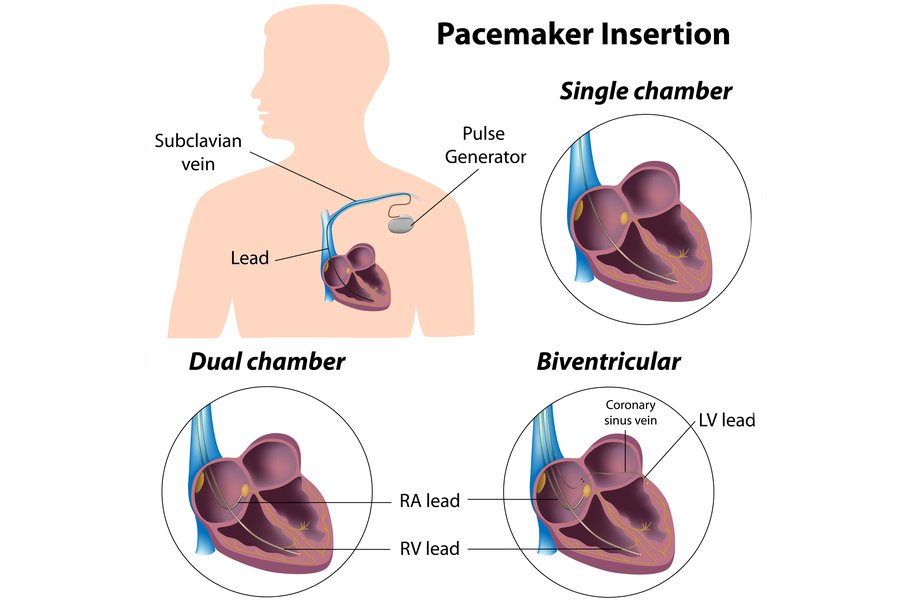Why it's performedPacemaker implantation
Pacemakers are sometimes recommended for people with conditions that cause the heart to beat abnormally.
Each time the heart beats, the heart muscle contracts (pulls inwards) in preparation for pumping blood around the body.
The contractions are triggered by electrical pulses. These are generated by a group of specialised cells known as the sinoatrial node (SA node).
The SA node is often referred to as a natural pacemaker because it generates a series of electrical pulses at regular intervals.
The pulse is then sent to a group of cells known as the atrioventricular node (AV node). The AV node relays the pulse to the 2 lower chambers of the heart (the ventricles).
A pacemaker or implantable cardioverter defibrillator (ICD) is needed when something disrupts this process and causes an abnormal heartbeat.
An abnormal heartbeat is called an arrhythmia. Here are some of the most common causes of arrhythmias:
Sick sinus syndrome
In sick sinus syndrome, the SA node doesn't work as it should. This can lead to an abnormally slow heartbeat (bradycardia), an abnormally fast heartbeat (tachycardia), or a combination of both.
Symptoms of sick sinus syndrome can include:
- a slower pulse than normal (bradycardia)
- extreme tiredness (fatigue)
- fainting (or nearly fainting)
- dizziness or lightheadedness
- shortness of breath
- chest pain
- irregular or fluttering heartbeats (palpitations)
Most cases of sick sinus syndrome are thought to be related to age.
Over time, the SA node tissue can become hardened and scarred. This can disrupt the normal pattern of electrical pulses released by the SA node.
Some types of medication can also trigger sick sinus syndrome as a side effect. These include calcium channel blockers and beta blockers.
Atrial fibrillation
Atrial fibrillation is a condition that causes the heart to beat abnormally fast.
This is usually considerably higher than 100 beats a minute (often 140 beats a minute or more).
Atrial fibrillation can usually be treated with medication, but some people don't respond to treatment, so a pacemaker may be recommended.
Sometimes people with atrial fibrillation can have a much slower pulse rate than normal, which can also be intermittent (not continuous).
In these cases, a pacemaker will usually be recommended.
Heart block
In people with heart block, the pulse that needs to be sent from the SA node to the AV node is either delayed or absent.
Heart block can be caused when the heart is damaged (acquired heart block), or it can occur if a baby is born with 1 or more defects that affect their heart (congenital heart block).
If you have heart block and it's causing troublesome symptoms, a pacemaker will usually be recommended.
Cardiac arrest
An implantable cardioverter defibrillator (ICD), which is a device similar to a pacemaker, is mainly used to prevent cardiac arrest.
A cardiac arrest is a potentially fatal condition where the electrical activity that controls the heart becomes so disrupted that the heart stops beating.
Unless it's treated quickly, a cardiac arrest will be fatal.
An ICD can detect abnormal electrical signals that could indicate that a cardiac arrest is about to happen.
If the ICD detects these type of signals, it sends a powerful electrical shock to the heart.
This basically "reboots" the heart. After the shock, the heart should start beating normally again.
An ICD implantation may be recommended if you have had a cardiac arrest in the past or it's thought you have a significant risk of having one in the future.
Factors that increase the risk of a cardiac arrest occurring include:
- coronary heart disease (where the main vessels that supply the heart become narrowed and hardened, reducing the blood supply)
- having a heart attack
- congenital heart disease (where a person is born with one or more defects affecting their heart)
- cardiomyopathy (abnormalities of the heart muscle, which leads to poor heart function)
Types of pacemaker
There are several different types of pacemaker.
The main types are:
- single-chamber pacemaker – this has 1 wire, which is connected to either the right atrium (upper heart chamber) or right ventricle (lower heart chamber)
- dual-chamber pacemaker – this has 2 wires, which are connected to the right atrium and right ventricle
- biventricular pacemaker – this has 3 wires, which are connected to the right atrium, right ventricle and left ventricle
The type of pacemaker you need will depend on your specific heart problem.
